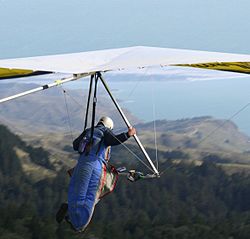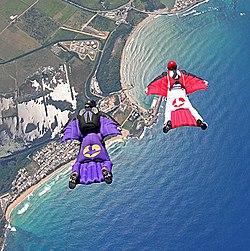Extreme sport: Difference between revisions
ExtremeTube (talk | contribs) |
ExtremeTube (talk | contribs) |
||
| Line 30: | Line 30: | ||
==Overview== |
==Overview== |
||
[[Image:ExtremeTube_Logo.gif|thumb| |
[[Image:ExtremeTube_Logo.gif|thumb|[[http://www.ExtremeTube.tv]] is your video sharing site featuring extreme videos from around the world]] |
||
While use of the term "Extreme Sports" has spread far and wide to describe a multitude of different activities, exactly which sports are considered 'extreme' is debatable. There are however several characteristics common to most extreme sports. While not the exclusive domain of youth, extreme sports tend to have a younger-than-average target demographic. Extreme sports are rarely sanctioned by schools. Extreme sports tend to be more solitary than traditional sports.<ref>{{cite web|url=http://www.americansportsdata.com/dev/pr-extremeactionsports.asp |title='Generation Y' drives increasingly popular... |date=August 1, 2002 |publisher=AmericanSportsData.com |accessdate=2008-07-11}}</ref> In addition, beginning extreme athletes tend to work on their craft without the guidance of a coach (though some may hire a coach later). |
While use of the term "Extreme Sports" has spread far and wide to describe a multitude of different activities, exactly which sports are considered 'extreme' is debatable. There are however several characteristics common to most extreme sports. While not the exclusive domain of youth, extreme sports tend to have a younger-than-average target demographic. Extreme sports are rarely sanctioned by schools. Extreme sports tend to be more solitary than traditional sports.<ref>{{cite web|url=http://www.americansportsdata.com/dev/pr-extremeactionsports.asp |title='Generation Y' drives increasingly popular... |date=August 1, 2002 |publisher=AmericanSportsData.com |accessdate=2008-07-11}}</ref> In addition, beginning extreme athletes tend to work on their craft without the guidance of a coach (though some may hire a coach later). |
||
Revision as of 16:37, 5 December 2008
This article possibly contains original research. (May 2008) |
Extreme Sports (also called action sport and adventure sport) is a media term for certain activities perceived as having a high level of inherent danger.[1][2][3] These activities often involve speed, height, high level of physical exertion, highly specialized gear or spectacular stunts.[1]
At present date, there are no careful studies or statistics of deaths to separate activities with low or normal level of danger from those with high level of danger. It is instead used as a marketing term in promoting events such as the X Games.

Overview
While use of the term "Extreme Sports" has spread far and wide to describe a multitude of different activities, exactly which sports are considered 'extreme' is debatable. There are however several characteristics common to most extreme sports. While not the exclusive domain of youth, extreme sports tend to have a younger-than-average target demographic. Extreme sports are rarely sanctioned by schools. Extreme sports tend to be more solitary than traditional sports.[4] In addition, beginning extreme athletes tend to work on their craft without the guidance of a coach (though some may hire a coach later).
Activities categorized by media as extreme sports differ from traditional sports due to the relatively higher number of inherently uncontrollable variables. Athletes in these activities compete not only against other athletes, but also against environmental obstacles and challenges. These environmental variables are frequently weather and terrain related, including wind, snow, water and mountains. Because these natural phenomena cannot be controlled, they inevitably affect the outcome of the given activity or event.
In a traditional sporting event, athletes compete against each other under controlled circumstances. While it is possible to create a controlled sporting event such as X Games, there are often variables that cannot be held constant for all athletes. Examples include snow conditions for snowboarders, rock and ice quality for climbers, and wave height for surfers.
Whilst traditional sporting judgment criteria may be adopted when assessing performance (distance, time, score etc), extreme sports performers are often evaluated on more subjective and aesthetic criteria [5]. This results in a tendency to reject unified judging methods, with different sports employing their own ideals [6] and indeed having the ability to evolve their assessment standards with new trends or developments in the sport.
History
This section needs expansion. You can help by adding to it. (June 2008) |
The history of several core "extreme sports" can be traced back to the splintering of the ancient Polynesian leisure activity now known as surfing, and the appropriation of existing-technology (the skateboard) for new purposes. In the 1970's surfers from Venice and Santa Monica, California began "surfing" on skateboards to keep their skills fresh in the surfing off-season. Until that time, skateboards had been seen more as a toy than a piece of athletic equipment, having enjoyed brief periods of popularity in the 50's and 60's.[7] As portrayed in the feature film "Lords of Dogtown" and the documentary "Dogtown and Z-Boys", skateboarding soon became a sport.[8][9] With the widespread availability of skating terrain, skateboarding eventually surpassed surfing in popularity. The popularity of extreme sports has continued to grow, branching in all directions to include land and sea-based events like surfboat rowing, street luge and windsurfing, and even aerial activities like skydiving and sky surfing.
The term extreme sport was populated by X Games, a multi-sport event created and developed by ESPN.[10][11] The first X Games (known as 1995 Extreme Games) were held in Newport, Providence, Mount Snow and Vermont in United States.[12][13]
Marketing

Some contend[citation needed] that the distinction between an extreme sport and a conventional one is as much to do with marketing as it is to do with perceptions about levels of danger involved or the amount of adrenaline generated. Furthermore a sport like rugby union, though dangerous and adrenaline-inducing, would not fall into the category of extreme sports due to its traditional image, and it does not have certain things that other extreme sports do, such as very high level of speed and an intention to perform stunts. Scuba diving is not seen as an extreme sport these days, despite the level of danger and physical exertion, because of its primarily adult demographic. Also the fact that it is not classed as a sport, as there is no objective to the activity. Another example: compare the perception of demolition derby, not usually thought of as an extreme sport, to that of BMX racing, which is. Demolition derby has an adult demographic, BMX is a youth sport.
In addition to the generational divide, one true hallmark of an extreme sport is a counter-cultural aura--a rejection of authority and the status quo by disaffected youth. The youth of Generation Y have seized upon activities which they can claim as their own, and have begun rejecting more traditional sports in increasing numbers.[14]
The definition of extreme sports may have shifted over the years due to marketing trends. When the term first surfaced circa the late 1980s/early 1990s, it was used for adult sports such as skydiving, scuba diving, surfing, rock climbing, snow skiing, water skiing, snowboarding, mountain biking, mountaineering, storm chasing, hang gliding, and bungee jumping, many of which were undergoing an unprecedented growth in popularity at the time. Outside magazine, not the X Games, epitomized the meaning of the term, and if there was a clothing style associated with extreme sports it was an "outdoorsy" look favoring brand names associated with mountaineering or backpacking such as The North Face and Patagonia, Teva sandals or hiking boots for footwear, etc. The term nowadays applies more to youth sports like skateboarding, snowboarding, aggressive skating, FMX and BMX and is closely associated with marketing efforts aimed at the younger generation (e.g. the ad campaigns of Mountain Dew), and with their favored styles of clothing and music, especially the kind of urban baggy look associated with skateboarders, and loud, fast alternative rock. This shift in styles may also be partly a generational shift, as Baby Boomers and Generation X have aged and marketing efforts associated with extreme sports shifted toward the younger Generation Y demographic sometime in the mid to late 1990s.
The term gained popularity with the advent of the X Games, a made-for-television collection of events. Advertisers were quick to recognize the appeal of the event to the public, as a consequence competitors and organizers are not wanting for sponsorship these days. The high profile of extreme sports and the culture surrounding them has also led people to invent parodies, such as Extreme ironing, urban housework, extreme croquet, and house gymnastics.
The difference between the serious extreme sports and imitation or parody is not always obvious.
Adrenaline rush

A feature of such activities in the view of some is their alleged capacity to induce an adrenaline rush in participants.[15] However, the medical view is that the rush or high associated with the activity is not due to adrenaline being released as a response to fear, but due to increased levels of dopamine, endorphins and serotonin because of the high level of physical exertion.[citation needed] Furthermore, a recent study suggests that the link to adrenaline and 'true' extreme sports is tentative.[16] The study defined 'true' extreme sports as a leisure or recreation activity where the most likely outcome of a mismanaged accident or mistake was death. This definition was designed to separate the marketing hype from the activity. Another characteristic of activities so labeled is they tend to be individual rather than team sports. Extreme sports can include both competitive and non-competitive activities.
Reasons

Eric Brymer PhD (2005) [17] also found that the potential of various extraordinary human experiences, many of which parallel those found in activities such as meditation, was an important part of the extreme sport experience.
Some of the sports have existed for decades and their proponents span generations, some going on to become well known personalities. Rock climbing and ice climbing have spawned publicly recognizable names such as Edmund Hillary, Chris Bonington, Wolfgang Gullich and more recently Joe Simpson. Another example is surfing, which was originally invented centuries ago by the native inhabitants of Hawaii.
See also
- Extreme Tube
- X Games
- Extremity Games
- Extreme tourism
- Gravity Games
- Urban Exploration
- Ekstremsportveko
References
- ^ a b Webster's New Millennium Dictionary of English, Preview Edition (v 0.9.7). extreme sport - definition. Dictionary.com. Retrieved 2007-06-11.
Extreme sports feature a combination of speed, height, danger and spectacular stunts.
{{cite book}}: CS1 maint: numeric names: authors list (link) - ^ The American Heritage Dictionary of the English Language, Fourth Edition by Houghton Mifflin Company. (2006). extreme - definition. Dictionary.com. Retrieved 2008-03-05.
6. Sports: a. Very dangerous or difficult: extreme rafting. b. Participating or tending to participate in a very dangerous or difficult sport: an extreme skier.
- ^ The Oxford Pocket Dictionary of Current English (2008). extreme - definition. Encyclopedia.com. Retrieved 2008-06-20.
Denoting or relating to a sport performed in a hazardous environment and involving great physical risk, such as parachuting or white-water rafting.
- ^ "'Generation Y' drives increasingly popular..." AmericanSportsData.com. August 1, 2002. Retrieved 2008-07-11.
- ^ Jungmin Lee,(2004)Extreme Sports Evaluation: Evidence from Judging Figure Skating,Econometric Society [1]
- ^ "'Adrenaline': Extreme Sports". 2006. Retrieved 2008-07-11.
- ^ Steve Cave. "Skateboarding: A Brief History". About.com. Retrieved 2008-07-27.
- ^ Stacy Peralta (2005). "Lords of Dogtown". Columbia Pictures Corporation. Retrieved 2008-07-27.
- ^ Stacy Peralta (2001). "Dogtown and Z-Boys". Agi Orsi Productions. Retrieved 2008-07-27.
- ^ "extreme sports". Britannica Concise Encyclopedia. 2007. Retrieved 2008-06-20.
- ^ Josh Krulewitz (1994). "Generation Ex - the Extreme Games, a competition for people with exceptional athletic talents". American Fitness. FindArticles.com. Retrieved 2008-06-20.
- ^ "Extreme Sports - Encarta". Microsoft Encarta Online Encyclopedia. 2008. Retrieved 2008-06-20.
- ^ "About International X Games". ESPN Internet Ventures. 2002. Retrieved 2008-06-20.
- ^ "'Generation Y' drives increasingly popular..." AmericanSportsData.com. August 1, 2002. Retrieved 2008-07-11.
- ^ "'Generation Y' Drives Increasingly Popular..." AmericanSportsData.com. August 1, 2002. Retrieved 2008-07-27.
- ^ Brymer, Eric and Gray, Tonia PhD, Extreme Sports: A Challenge to Phenomenology. University of Wollongong, Australia, 2004
- ^ Brymer, Eric PHD, Extreme Dude: A Phenomenological Perspective on the Extreme sports experience . University of Wollongong, Australia, 2005 [2]
